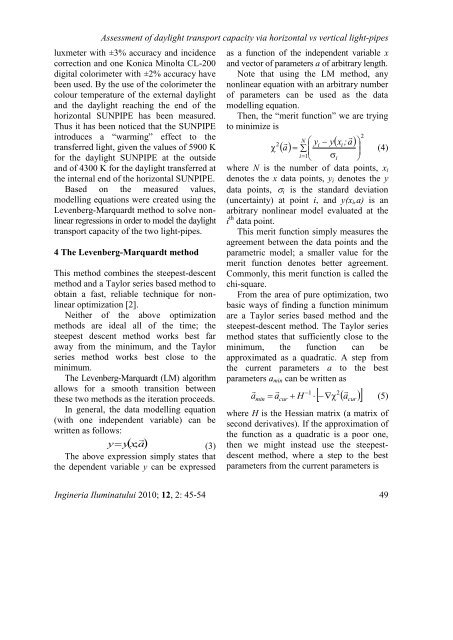ingineria iluminatului - Journal of Lighting Engineering - Prof. Florin ...
ingineria iluminatului - Journal of Lighting Engineering - Prof. Florin ...
ingineria iluminatului - Journal of Lighting Engineering - Prof. Florin ...
You also want an ePaper? Increase the reach of your titles
YUMPU automatically turns print PDFs into web optimized ePapers that Google loves.
Assessment <strong>of</strong> daylight transport capacity via horizontal vs vertical light-pipes<br />
luxmeter with ±3% accuracy and incidence<br />
correction and one Konica Minolta CL-200<br />
digital colorimeter with ±2% accuracy have<br />
been used. By the use <strong>of</strong> the colorimeter the<br />
colour temperature <strong>of</strong> the external daylight<br />
and the daylight reaching the end <strong>of</strong> the<br />
horizontal SUNPIPE has been measured.<br />
Thus it has been noticed that the SUNPIPE<br />
introduces a “warming” effect to the<br />
transferred light, given the values <strong>of</strong> 5900 K<br />
for the daylight SUNPIPE at the outside<br />
and <strong>of</strong> 4300 K for the daylight transferred at<br />
the internal end <strong>of</strong> the horizontal SUNPIPE.<br />
Based on the measured values,<br />
modelling equations were created using the<br />
Levenberg-Marquardt method to solve nonlinear<br />
regressions in order to model the daylight<br />
transport capacity <strong>of</strong> the two light-pipes.<br />
4 The Levenberg-Marquardt method<br />
This method combines the steepest-descent<br />
method and a Taylor series based method to<br />
obtain a fast, reliable technique for nonlinear<br />
optimization [2].<br />
Neither <strong>of</strong> the above optimization<br />
methods are ideal all <strong>of</strong> the time; the<br />
steepest descent method works best far<br />
away from the minimum, and the Taylor<br />
series method works best close to the<br />
minimum.<br />
The Levenberg-Marquardt (LM) algorithm<br />
allows for a smooth transition between<br />
these two methods as the iteration proceeds.<br />
In general, the data modelling equation<br />
(with one independent variable) can be<br />
written as follows:<br />
<br />
y<br />
yx;<br />
a<br />
(3)<br />
The above expression simply states that<br />
the dependent variable y can be expressed<br />
as a function <strong>of</strong> the independent variable x<br />
and vector <strong>of</strong> parameters a <strong>of</strong> arbitrary length.<br />
Note that using the LM method, any<br />
nonlinear equation with an arbitrary number<br />
<strong>of</strong> parameters can be used as the data<br />
modelling equation.<br />
Then, the “merit function” we are trying<br />
to minimize is<br />
<br />
<br />
<br />
2<br />
N<br />
2 y <br />
<br />
<br />
i y xi<br />
; a<br />
a<br />
(4)<br />
i1 i<br />
<br />
where N is the number <strong>of</strong> data points, xi<br />
denotes the x data points, yi denotes the y<br />
data points, i is the standard deviation<br />
(uncertainty) at point i, and y(xi,a) is an<br />
arbitrary nonlinear model evaluated at the<br />
i th data point.<br />
This merit function simply measures the<br />
agreement between the data points and the<br />
parametric model; a smaller value for the<br />
merit function denotes better agreement.<br />
Commonly, this merit function is called the<br />
chi-square.<br />
From the area <strong>of</strong> pure optimization, two<br />
basic ways <strong>of</strong> finding a function minimum<br />
are a Taylor series based method and the<br />
steepest-descent method. The Taylor series<br />
method states that sufficiently close to the<br />
minimum, the function can be<br />
approximated as a quadratic. A step from<br />
the current parameters a to the best<br />
parameters amin can be written as<br />
<br />
a<br />
<br />
a<br />
1<br />
2 <br />
H <br />
a<br />
<br />
Ingineria Iluminatului 2010; 12, 2: 45-54 49<br />
min<br />
cur<br />
cur<br />
(5)<br />
where H is the Hessian matrix (a matrix <strong>of</strong><br />
second derivatives). If the approximation <strong>of</strong><br />
the function as a quadratic is a poor one,<br />
then we might instead use the steepestdescent<br />
method, where a step to the best<br />
parameters from the current parameters is
















